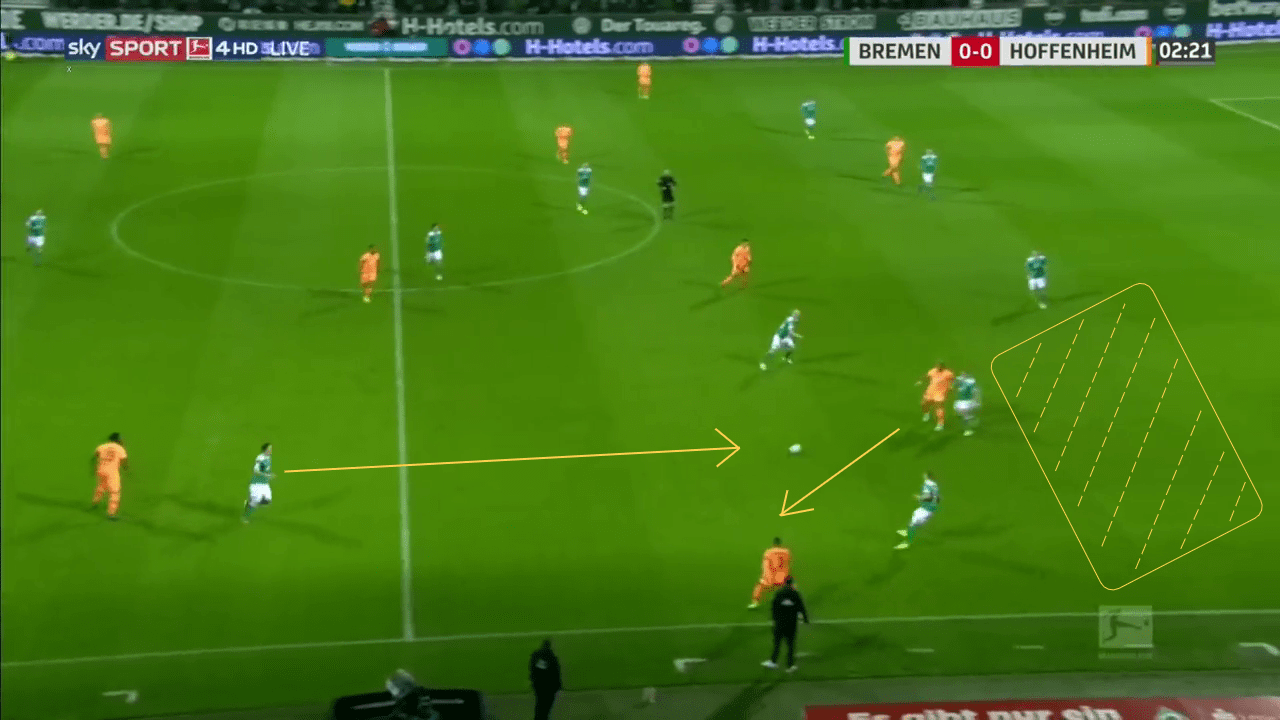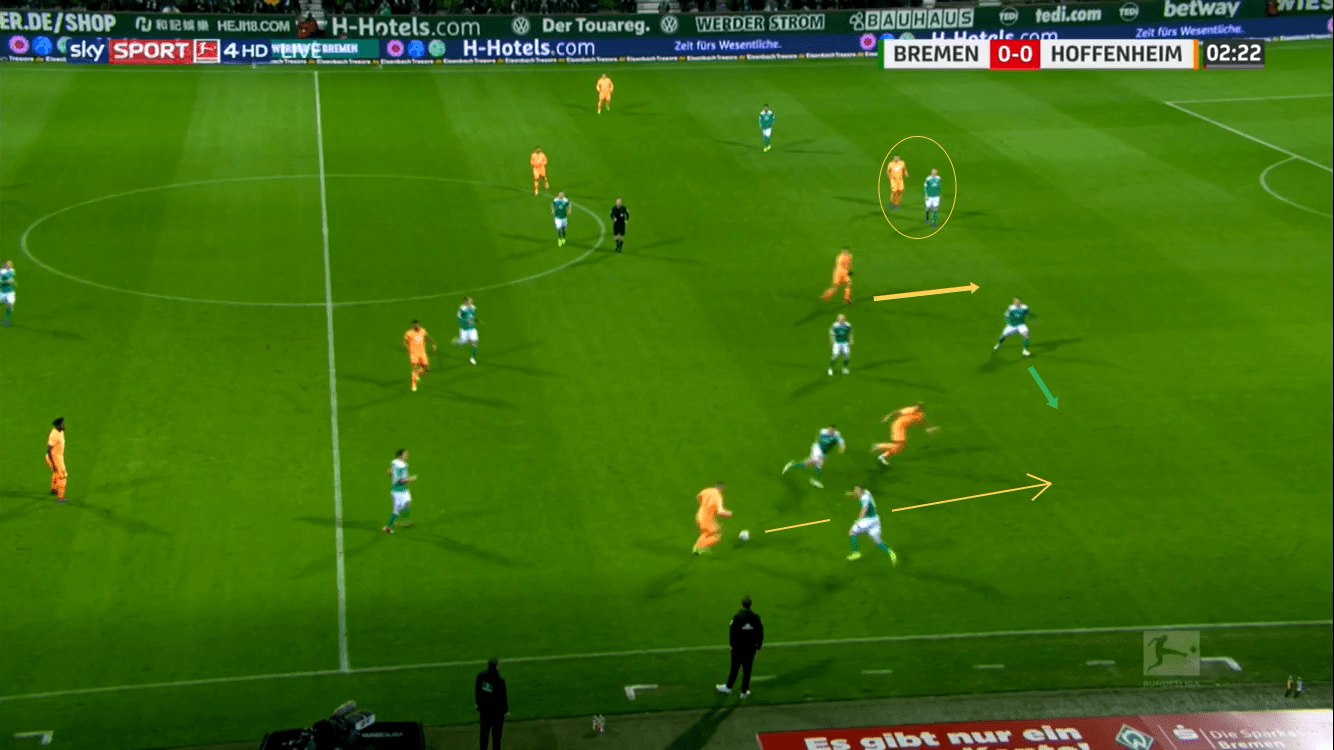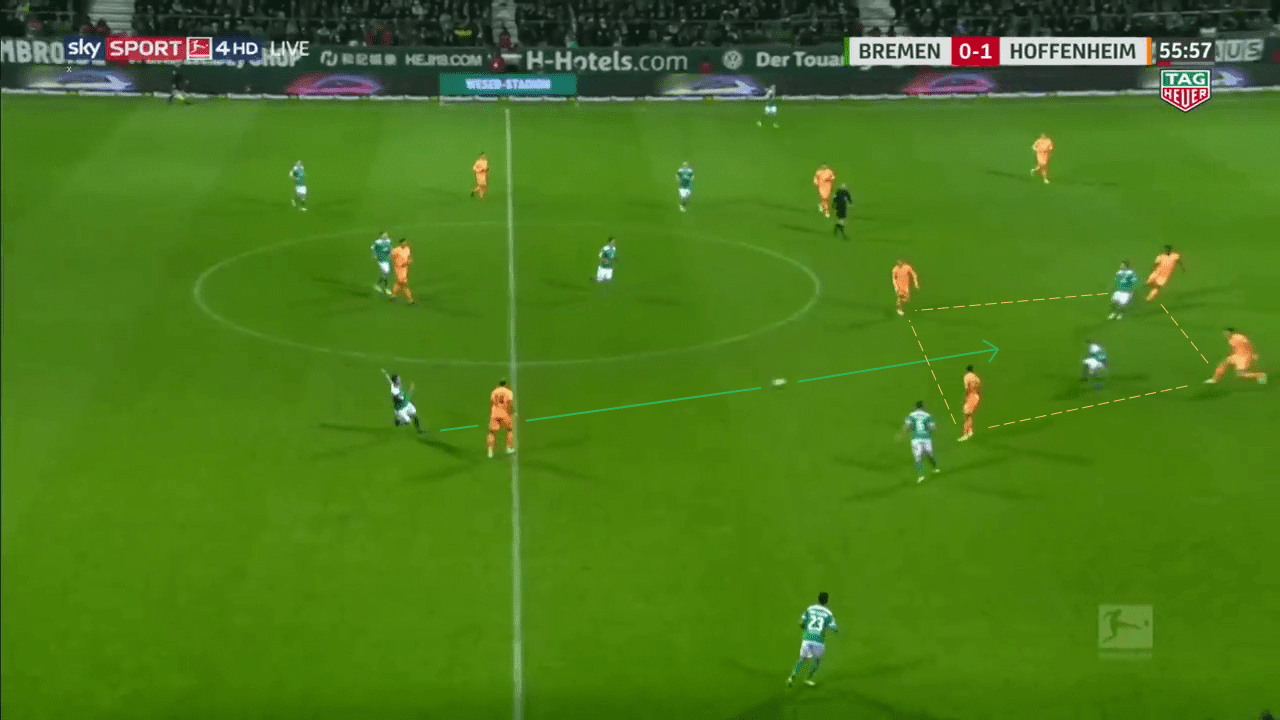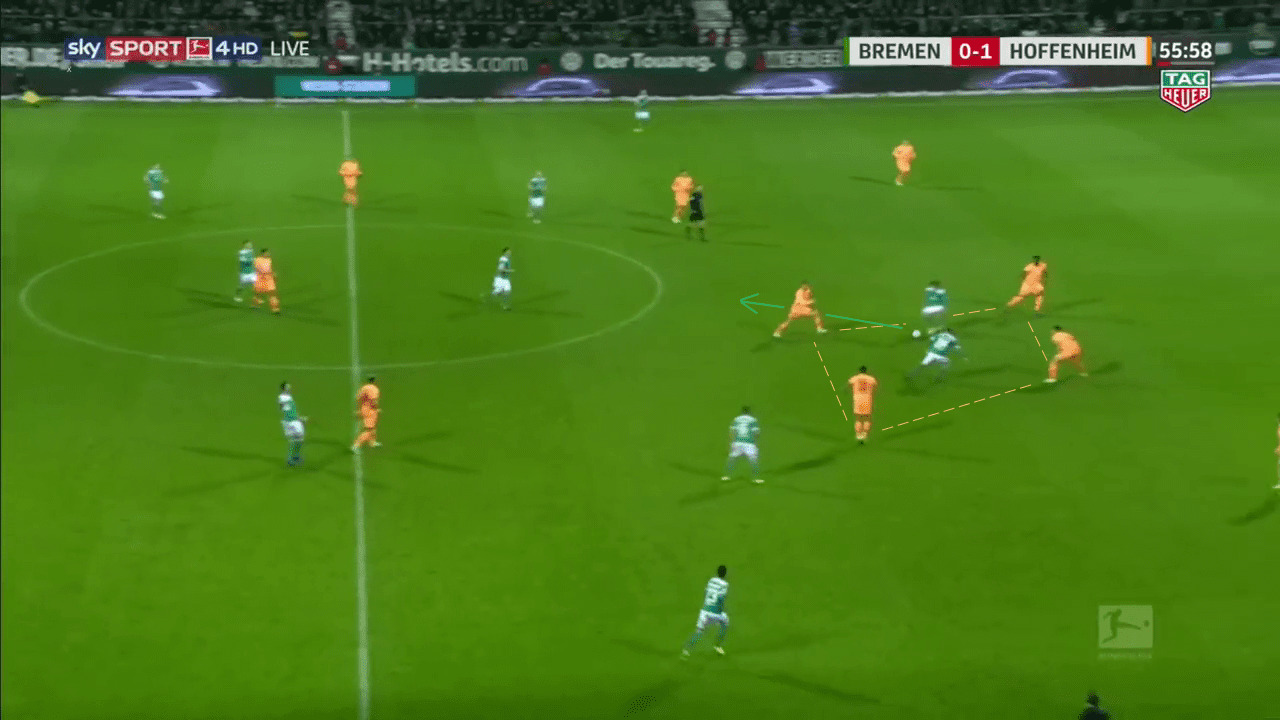Only two points separated both teams from each other in the Bundesliga table. The European Cup places are within reach for both of them which promised an exciting game.
Not only the table situation suggested an exciting match but also the duel of two of the most promising young German coaches, Florian Kohfeldt and Julian Nagelsmann.
In this analysis, I will look at how Kohfeldt and Nagelsmann set up their teams, especially from a tactical point of view.
Line ups
Werder Bremen lined up in a 4-3-1-2/4-4-2 diamond. Maximilian Eggestein often joined the back-line in defensive phases in order to support the centre-backs and avoid 1v1 situations against Hoffenheim’s strikers Adam Szalai and Joelinton. The second reason was that Hoffenheim’s strikers often dropped, Bremen’s centre-backs tracked them so Eggestein covered the gap they left.
Hoffenheim’s formation was fluid, especially in midfield. That was due to Kramaric’s role. His positioning changed depending on the situation. In build-up phases, he often joined Kerem Demirbay and Leonardo Bittencourt in central midfield. In more advanced phases he was active as an offensive midfielder.
Pressing approach
Bremen varied their pressing line in the first half. They mostly began pressing when Hoffenheim reached the centre circle but they also pressed very high up the pitch occasionally. The pressing-trigger was most often a pass from the central defender Stefan Posch to one of the half-backs (P1). Posch was forced to play these passes often because Hoffenheim’s playmaker Demirbay was man-marked or the passing lane was closed by Yuya Osako. This took the possibility from the guests to find him in the centre and control the flow of their possession therefrom.

Due to the diamond-midfield, Bremen had a strong presence in midfield and especially in the halfspaces where Klaassen and Möhwald were positioned. This made it very difficult for Nagelsmann’s side to find Bittencourt or Kramaric there. Often Hoffenheim had to pass to their wing-backs who were immediately pressed by Bremen’s full-backs.
Hoffenheim’s struggle for solutions
The mentioned points gave Hoffenheim little time to spend in the halfspaces in the opponent’s half or even reach them. Therefore, the strikers dropped often in order to receive vertical passes from the half-backs. Then, mostly they played lay-off passes to the wing-backs. Bremen’s centre-backs tracked the dropping strikers which created space behind them. After the lay-off pass, the dropping striker attacked the created space with an aggressive vertical run (P2.1 & P2.2).


Though, after few times it became too predictable for the opponent’s defenders. The centre-backs marked the strikers even tighter and teammates anticipated the passes.
Possible solutions
Bringing more variety in their attacking game would have caused more threats for the opponent. In the picture below, you can see that Posch decides to pass the ball to the half-back. As I already mentioned, this was a pressing-trigger for Kohfeldt’s side and almost all of Posch’s passes were played to a half-back. But Werder’s strikers didn’t press Posch at all most of the time. As a starting point for the following two possible solutions, I will take P3.

As a possible solution in order to bring in more variety, Hoffenheim’s central defender could have disorganized Werder’s patterns with continuing to dribble towards the opponent’s half. At some point, someone would have had to press him which would have opened space for another player. If Osako would have pressed him for example, it would have created space for Demirbay to receive the ball in the centre.
Another opportunity could have been an adapting of the central midfielders’ positioning in such situations. In P3, you can see that Bittencourt (orange player next to the referee) is positioned in the halfspace but very close to the centre which is already condensed. This makes it even better for the opponent’s central midfielder to stay in the halfspace which blocks vertical passes from Posch to the strikers. If Bittencourt would position himself wider, closer to the touch-line, the opponent’s midfielder would have to make a decision: either staying where he is or staying closer to Bittencourt which would draw him out of the halfspace.
Outcome
No matter which decision Hoffenheim’s midfielder makes, they would benefit from it. In the first case, Bittencourt would lose his marker and give Posch the option to play a diagonal pass to him. Bittencourt would have the opportunity to receive the ball with more space and his body directed towards the centre which allows him to get a view of a bigger and in this case more relevant part of the pitch. Receiving a vertical pass with his body directed to Posch wouldn’t give him that opportunity. In order to create even more space for Bittencourt, the left wing-back Nico Schulz could position himself higher up the pitch to pin the opponent’s fullback who then wouldn’t be able to press Bittencourt.
In the second case, Bremen’s central midfielder’s movement would open up a passing lane for Posch to play a vertical pass to a dropping striker.
Hoffenheim’s pressing
Nagelsmann’s side is well-known for their brave pressing. They put their opponents under high pressure very early in the build-up phase and force them to play many long balls. This helps them to win possession.
Against Bremen, Hoffenheim often used to leave the centre-backs free for a pass. While the ball is on the way to the centre-back, the strikers begin to press them coming from the centre. That takes the possibility away from the pass receiver to pass the ball to the other centre-back. In this way, they push them to the touch-line. Then, they mark all options around the ball. Finally, the opponent is forced to play a long ball which is easy to defend (P4).

This approach led to the result that Werder couldn’t build up properly and often lost possession by playing a long ball.
Schulz’s contribution
The German national player Nico Schulz was very active down the left wing, especially in the first half. He played the most crosses of his team (8) and attempted the second most dribbles*. He also assisted Bittencourt’s goal with a cross after attacking down the left wing.
Kohfeldt adapts
In the second half, Bremen permanently pressed Hoffenheim’s build-up play. This factor added to Hoffenheim’s drop of courage to take risks in their build-up and the drop of concentration led to many long balls and consequently losing possession quickly.
In the 57th minute, Bremen managed to equalize after Gebre Selassie’s header. It was a beautiful goal after a well-executed build-up play, direct passes in midfield, attracting opponents and finding the free man on the wing (P5.1 & P5.2).


Bremen was the better team in the second half where Hoffenheim’s players weren’t able to maintain the intensity until the end of the match. In the last minutes of the match, both teams lacked discipline, left the midfield free and faced only few defenders. Though, both teams didn’t score. Especially, Bremen’s Rashica had many chances after he came in for Davy Klaassen.
Conclusion
The first half showed some interesting aspects from a tactical point of view. Both teams struggled to dominate the match but they managed to neutralize the opponent’s strengths mostly.
In the second half, Bremen had many opportunities to win all three points but Rashica failed to convert his chances. Especially in the last minutes, there wasn’t tactical discipline at all. This led to situations which are untypical for both sides.
If you love tactical analysis, then you’ll love the digital magazines from totalfootballanalysis.com – a guaranteed 100+ pages of pure tactical analysis covering topics from the Premier League, Serie A, La Liga, Bundesliga and many, many more. Get your copy of the FIRST of two December issues for just £4.99 here or preorder the SECOND of the December issues with an annual membership right here.





Comments